The Shroud of Turin - Forgery?
Starting off with a religious subject - The Shroud of Turin.
For those who don't know, the Shroud of Turin is a centuries old linen cloth that bears the image of a crucified man. A man that millions believe to be Jesus of Nazareth. Experts say the linen cloth, contains 'nanoparticles' which are not typical of the blood of a healthy person. The shroud is today kept in the royal chapel of the Cathedral of Saint John the Baptist in Turin, northern Italy.
According to legend, the shroud was secretly carried from Judea in A.D. 30 or 33, and was housed in Edessa, Turkey, and Constantinople for centuries. After crusaders sacked Constantinople in A.D. 1204, the cloth was smuggled to safety in Athens, Greece, where it stayed until A.D. 1225.
In the 1980s, researches suggested the shroud was made between A.D. 1260 and A.D. 1390, lending credence to the notion that it was an elaborate fake created in the Middle Ages.
A group of experts analyzed dust that they vacuumed from the shroud that contained traces of both plant and human DNA. The team also sequenced the human mitochondrial DNA (DNA passed from mother to child) found in dust from the shroud. The genetic lineage of the DNA suggested that people ranging from North African Berbers to East Africans to inhabitants of China touched the garment.
However, they too had doubts saying it was very bold and completely wrong to use the same approach on the presence of DNA — or just a few pollen grains, for that matter — on a shroud that has been man-handled for decades. Given that the cloth was publicly displayed for centuries, it's not surprising that so many people touched it. Apart from ruling out the United States of America as the source for the shroud, it leaves just about everything else open.
After decades of researching using DNA analysis and more sophisticated scientific techniques could ultimately settle the question. For instance, geologists can now determine the origin of rock with incredible precision, by analyzing its ratio of isotopes of certain elements. If researchers can one day figure out how to test the isotopes in the limestone dust found on the shroud, they could say with greater certainty whether the shroud was ever in Jerusalem. Was it really?
Researchers say the latest discovery was made possible because of new technology.
These findings could only be revealed by the methods recently developed in the field of electron microscopy, the research marked the first study of "the nanoscale properties of a pristine fiber taken from the Turin Shroud" they say.
When it comes to the question of whether this is the actual burial shroud of Christ, no one can know for sure.
The evidence that it is a man who was tortured was there. We cannot say who it is.
What do you think about this? Is this just another religious hoax? Or could this be a real deal?


Hi! I am a robot. I just upvoted you! I found similar content that readers might be interested in:
https://www.yahoo.com/news/fake-dna-testing-deepens-mystery-shroud-turin-110535010.html